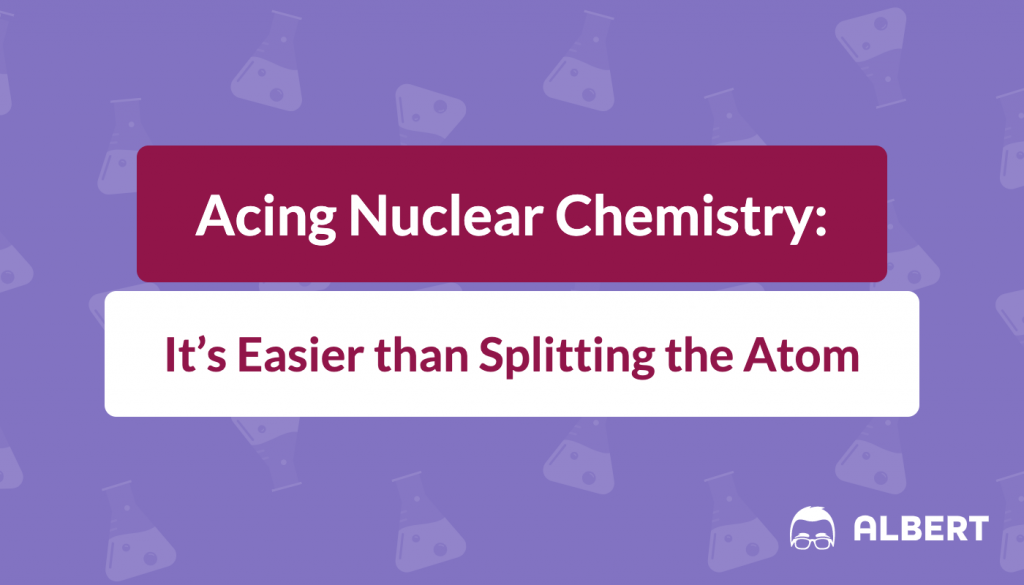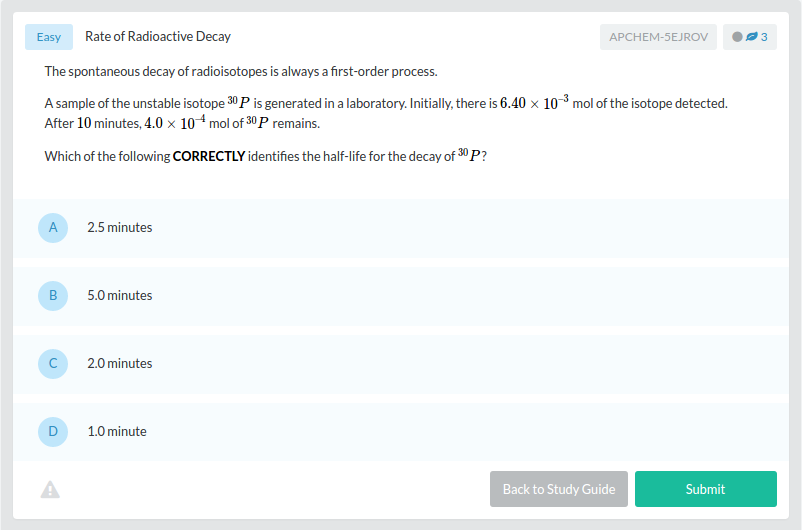The basics of nuclear chemistry start with radioactive decay. When unstable molecules break down, they emit one or more of several types of particles: alpha, beta, proton, neutron, and positron.
Alpha particles are helium nuclei and have an atomic mass of 4 and a charge of +2. Beta particles are electrons with negligible mass and a charge of -1. Protons and neutrons are their usual selves, and positrons are just electrons with a +1 charge.
Decay is represented by nuclear reaction equations. Like their chemical reaction counterparts, nuclear equations have a set of reagents that lead to a set of products. Additionally, these equations need to be balanced. Let’s look at an example:
_{ 86 }^{ 222 }{ Rn }\longrightarrow _{ 84 }^{ 218 }{Po }+_{ 2 }^{ 4 }{ He }
Here we have the decay of radon-222, which emits an alpha particle (helium) and becomes polonium-218. As you can see, the equation is balanced for both atomic mass and charge, which must always be the case. Also, be wary of alternate notations. The above is most common, but do refer to the table below for a full list of symbols used in nuclear equations.
Name |
Symbol |
| Alpha | \begin{matrix} 4 \ 2 \end{matrix} He \quad or \quad \begin{matrix} 4 \ 2 \end{matrix} \alpha |
| Beta | \begin{matrix} 0 \ 1 \end{matrix}e\quad or\quad \begin{matrix} 0 \ -1 \end{matrix}\beta |
| Proton | \begin{matrix} 1 \ 1 \end{matrix}h\quad or\quad \begin{matrix} 1 \ 1 \end{matrix}p |
| Neutron | \begin{matrix} 1 \ 0 \end{matrix}n |
| Positron | \begin{matrix} 0 \ +1 \end{matrix}e\quad or\quad \begin{matrix} 0 \ +1 \end{matrix}\beta |
Some isotopes also emit gamma rays when they decay. These dense bursts of energy do not have mass or charge, and thus do not need to be accounted for in nuclear equations.
Now that we understand how things decay, we want to be able to know how quickly they decay. The radioactivity of isotopes is usually compared by talking about their half-life: the amount of time it takes for half of a sample of an isotope to decay. The equation for the number of radioactive decays per second is the following:
\text{Rate}=kN
\text{Rate=(Constant)(Number of radioactive atoms)}
We can modify the equation by integrating:
ln { \left( \dfrac { { N }_{ o } }{ { N }_{ t } } \right) } =kt
…where N_0 is the original number of radioactive atoms,N_t is the number of radioactive atoms remaining after t seconds, k is the rate constant (in units of Hertz), and t is the time in seconds from the start of the experiment.
When half of the atoms have decayed, N_0= 2N_t. We can make a substitution to find an equation for the half-life of an isotope:
ln { \left( \dfrac { { 2N }_{ t } }{ { N }_{ t } } \right) } ={ kt }_{ { 1 }/{ 2 } }
This can be further to simplified to:
{ t }_{1/2}=\dfrac { 0.693 }{ k }
Our understanding of half-lives also yields an equation for the fraction of the original sample left after a certain number of half-lives:
\text{Fraction Left}={ \left( \dfrac { 1 }{ 2 } \right) }^{ \text{number of half-lives} }
A good understanding of those four equations will have you able to solve any problem related to half-life. Simply be able to apply the right equation at the right time and plug in the appropriate numbers.
That covers the most important nuclear chemistry concepts you’ll need to know for the AP® exam. As promised, actually splitting an atom is much more difficult.
Let’s put everything into practice. Try this AP® Chemistry practice question:
Looking for more AP® Chemistry practice?
Check out our other articles on AP® Chemistry.
You can also find thousands of practice questions on Albert.io. Albert.io lets you customize your learning experience to target practice where you need the most help. We’ll give you challenging practice questions to help you achieve mastery of AP® Chemistry.
Start practicing here.
Are you a teacher or administrator interested in boosting AP® Chemistry student outcomes?
Learn more about our school licenses here.










2 thoughts on “Acing Nuclear Chemistry: It’s Easier than Splitting the Atom”
Hi! I got to this article from your post about Ultimate tips for AP® Chemistry tips. There it lists nuclear chemistry as a topic that is NOT included on the AP® Chemistry exam, but here it says nuclear chemistry is a “decent chunk” of the exam. I’m teaching AP® Chem for the first time this year, and this has me very confused. Can you please clarify this contradiction for me?
Thanks so much!
Great question! Nuclear chemistry was removed as a topic in 2014 when the exam was reformatted. We will remedy the article to eliminate future confusion. Thanks!
Comments are closed.